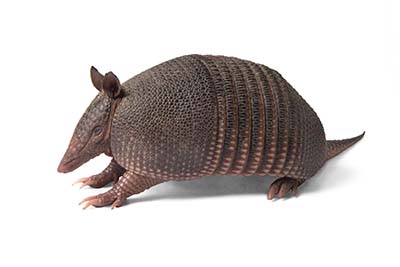Latin Name: Cingulata

They have 20 species, with only one living in Latin America. The word Armadillos is a Spanish word for “little armored one.” This creature got this name because of its bony plates covering the head, back, tail, and kegs. They are the only living creature that still wears shells till date.
They are related to sloths and are generally known for their pointy snout and small eyes. They vary in color and size and encase themselves in their shells to protect themselves from predators. If you are wondering what harm they could cause in your home and prevent them, continue reading the following information to find out.
It has a piece of many other animal parts. It has the shell of a turtle, the feet of a lizard, the face of a pig, and the ears of an aardvark. However, although they could be easily mistaken for reptiles or amphibians, the bands, of course, bristles and hairs on their bodies show that they are true mammals. Some extinct species of armadillo grew to have massive sizes and were used for roofs and tombs by the early South American Indians.
They have bands with a double-layered covering of horn and bone from the skin that covers most of the upper sides of the body. Its forcible skin connects their bony bands. They have a bony shield that caps their head while skinny rings and plates encase their tail. However, soft and hairy skin covers its underside.
Armadillos have elongated and flattened heads with a long and extendable tongue. Their jaws are usually small and peglike. They have teeth not covered by enamel, and they grow continuously. Their forelimbs have three to five curved claws that fit digging, and the hind limbs have five clawed toes.
Armadillos live in warm and temperate habitats, including other regions like grassland, rainforests, and semi-deserts. They are found mainly in South and Central America. They often experience low metabolic rates. Hence they can not dislike cold areas and intemperate weather. Such regions can wipe out a whole population. Also, the cold prevents the spread of insects which is one of their principal food. Some of them are found digging burrows and can sleep for 16 hours every day.
The most common species are the long-nosed, nine-banded armadillos. In 1922, they escaped from Florida to move to Texas. Rivers and streams are no barriers to armadillos. They can gulp air into their stomach to buoy themselves and even float in the eater.
Armadillos are known to be primarily nocturnal. Their teeth dictate their feeding habits. Those with sturdy teeth eat snails, worms, tubers, fruits, insects, and small lizards. Those with soft teeth eat insects like termites and ants primarily. They can even eat close to 40,000 ants at one feeding.
Armadillos have a keen sense of smell that helps them to locate their prey buried underground. They dig the soil at incredible speed to find that prey with the nose pressed to the ground.
They run very fast, which helps them get away from predators. Their armor also protects them from cactus and thorny undergrowth. Their strong legs and claws are for digging. They also use their long, sticky tongue to extract ants and termites from tunnels.
Armadillos are incredibly irritating to see in your environment. Homeowners are known to see armadillos excavating and rooting for insects in their lawns. Hence, an obvious sign of armadillos is the sight of them destroying the landscape. They often make holes as deep as three inches and five inches wide.
Armadillos make holes in vegetable gardens and flower beds, especially when digging for earthworms, insects, grubs, and plants. These holes can destabilize foundations, structures, and driveways. Their holes can also injure livestock.
Although they hardly transmit diseases, some of them are known to carry bacteria that cause leprosy.
Armadillos are both climbers and burrows. Hence if you use fences to serve as barriers, it will only exclude them temporarily. Also, removing the insects that could invite them is not an easy task. A better way to of event them is to remove heavy woodpiles that may attract them.
If you suspect these pests are in or around your home, give us a call for a Free Home Inspection!
Loading…
